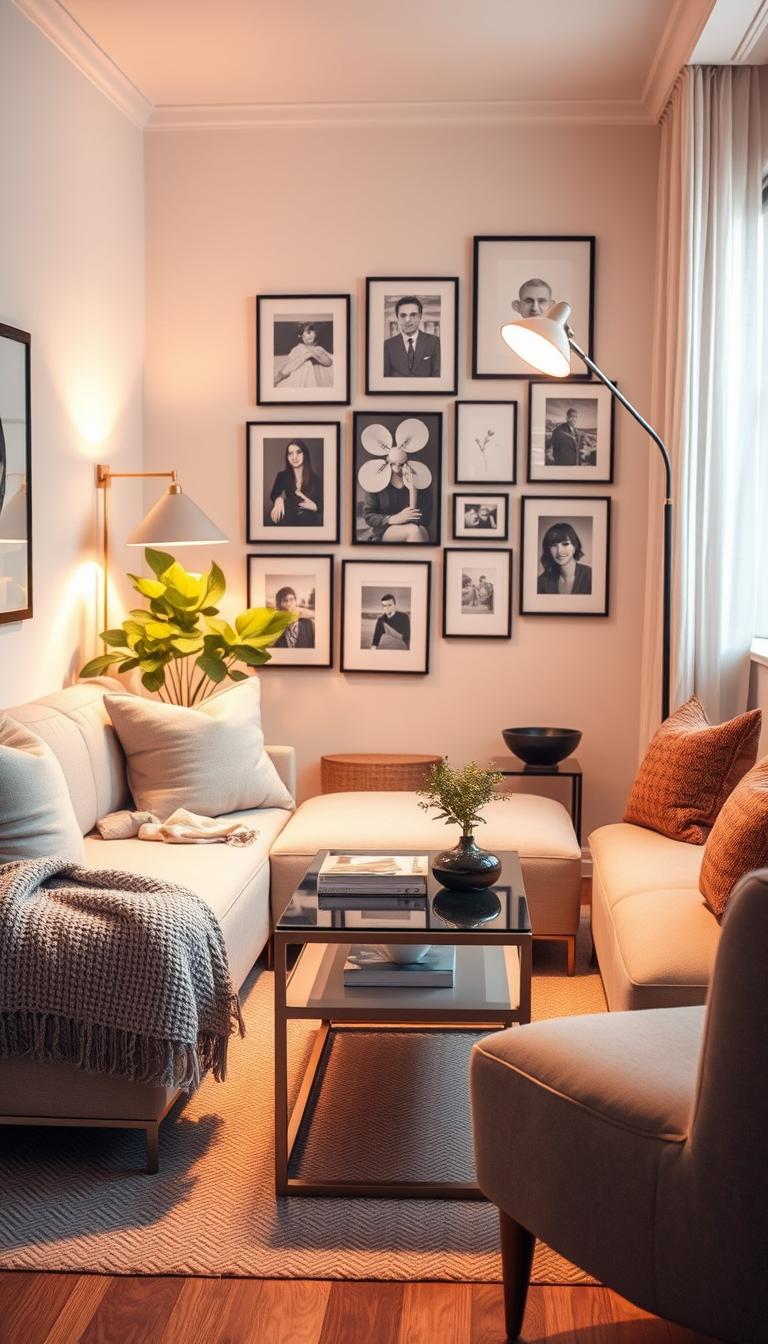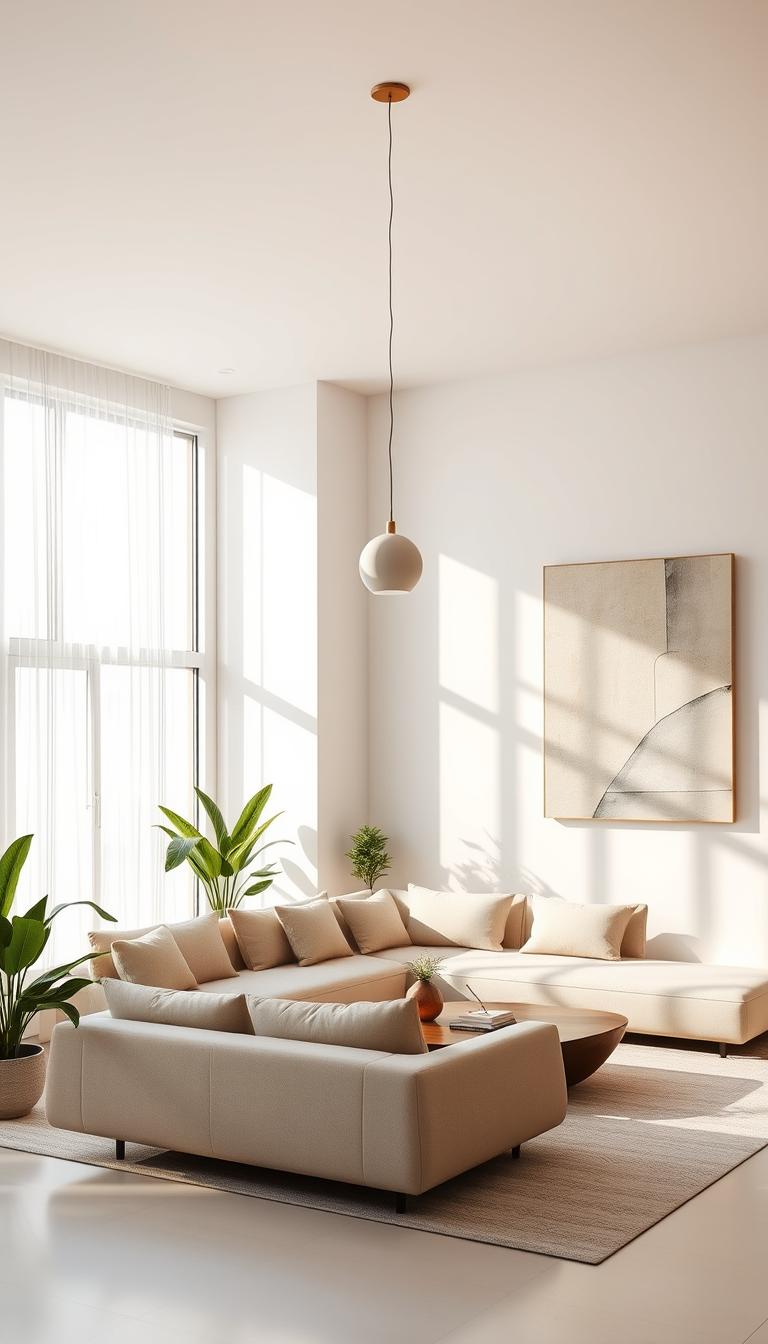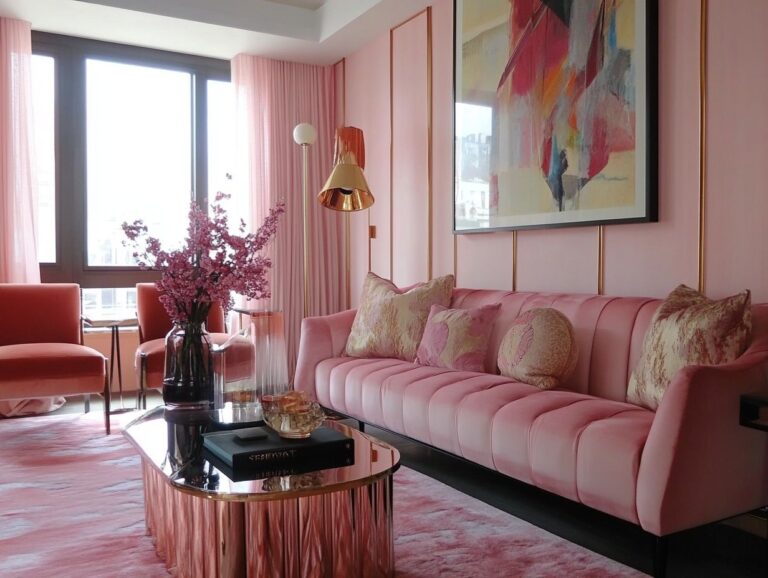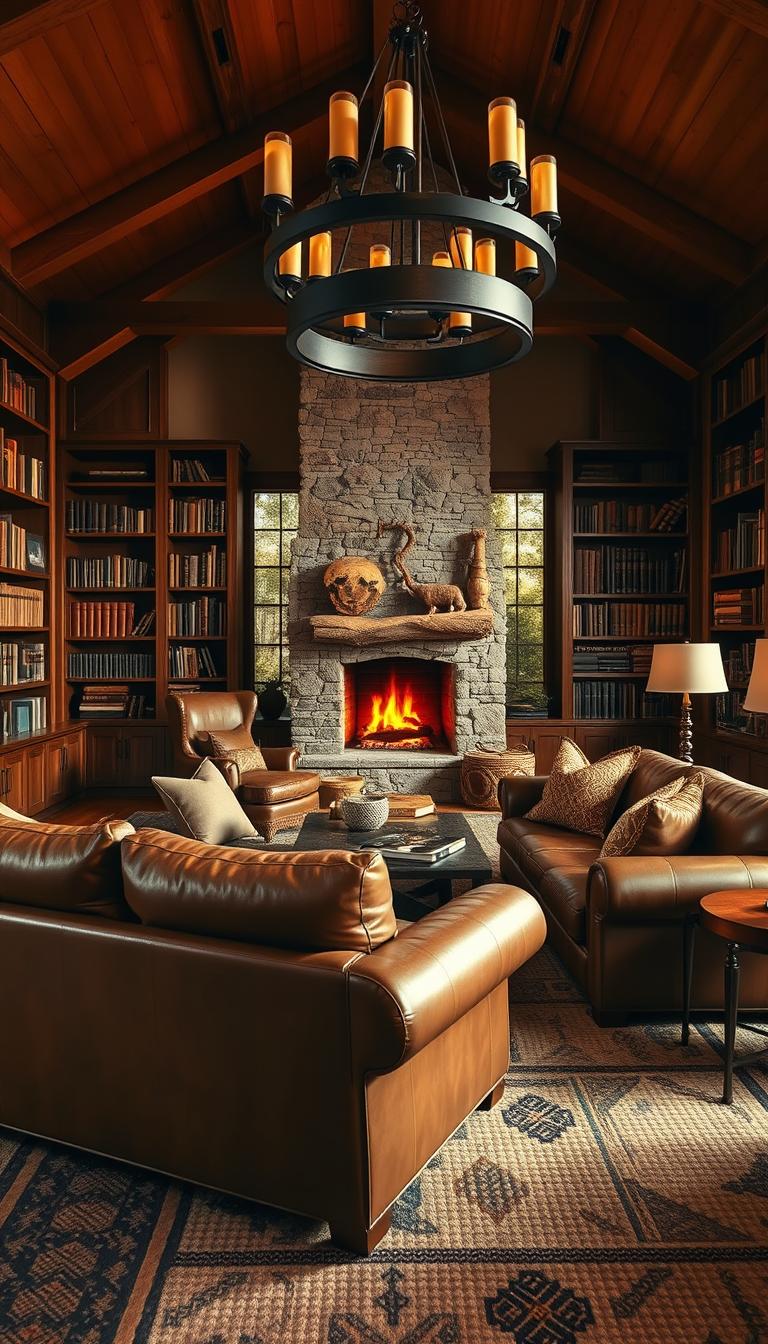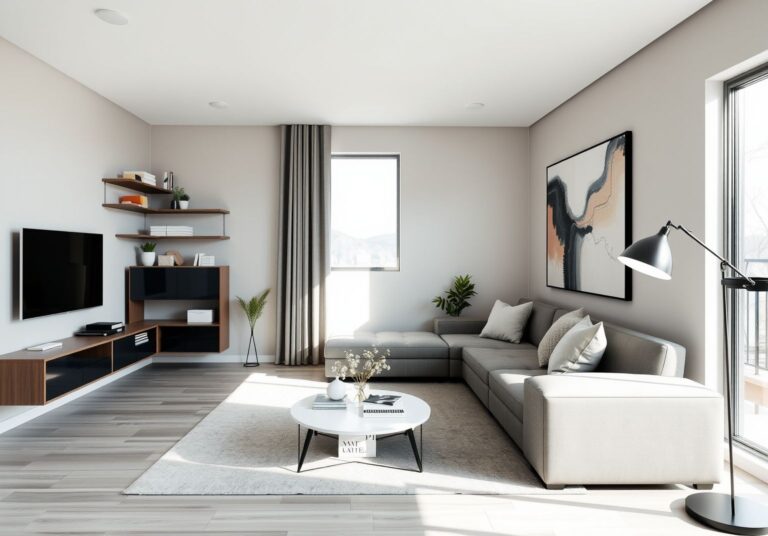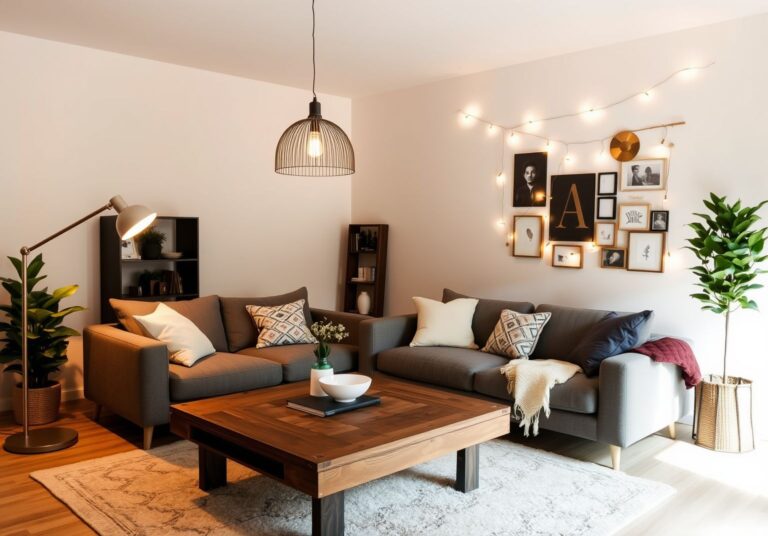Enhance Your Small Living Space with Chic Decor
Creating a stylish and functional area doesn’t require endless square footage—just smart design choices. Whether you’re in a cozy apartment or a compact home, the right approach can turn limitations into opportunities. Let’s explore how intentional styling elevates both practicality and visual appeal.
Strategic layouts and multipurpose furniture are game-changers. For example, London designers often use custom-built sofas that double as storage units or foldable tables that vanish when not in use. Clever lighting, like layered fixtures or wall-mounted lamps, adds depth without cluttering surfaces.
Personal touches matter, too. A bold accent wall or curated gallery creates character, while mirrors amplify natural light. These tricks help even tight quarters feel airy and uniquely yours.
Ready to reimagine your home? Keep reading for actionable tips, budget-friendly DIY projects, and inspiration from real spaces that master the art of balancing form and function.
Understanding Your Space and Setting Goals
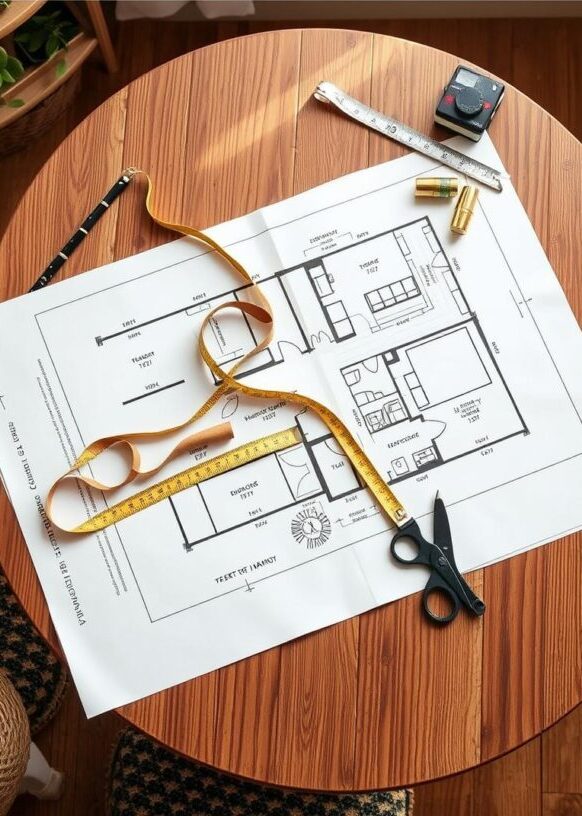
Before selecting furnishings, grab a tape measure—it’s your secret weapon. Top designers insist that knowing your exact dimensions prevents costly mistakes. Jot down wall lengths, door swings, and outlet locations. These details shape smarter furniture choices.
Define your priorities early. Is this zone for movie nights, remote work, or hosting friends? New York-based firm Studio NAB uses 3D apps to test layouts digitally before committing. Their projects often feature ottomans with hidden storage or wall-mounted desks to preserve floor space.
Try the “zoning” method: divide your area into activity sections using rugs or lighting. A client in Chicago maximized a 300-square-foot studio by defining separate sleeping and dining zones with a bookshelf divider. This trick makes compact layouts feel organized.
Collect inspiration photos and fabric swatches to build a cohesive mood board. Notice patterns—do you lean toward minimalist lines or bold patterns? Balance hardworking basics like foldable chairs with one statement piece, like a sculptural lamp.
Planning a Functional Layout for Small Living Areas
Maximizing flow in tight zones starts with intentional arrangement of key pieces. Designers like Milan-based Studio A+ prioritize creating clear pathways by floating sofas away from walls. This trick instantly makes areas feel more open while improving traffic patterns.
Choose furnishings that match your proportions. Slim-arm chairs or apartment-sized sectionals work better than bulky counterparts. Los Angeles designer Mara Santos uses modular pieces that can shift from daytime seating to evening guest beds. Another tip? Keep at least 18 inches between coffee tables and seating for easy movement.
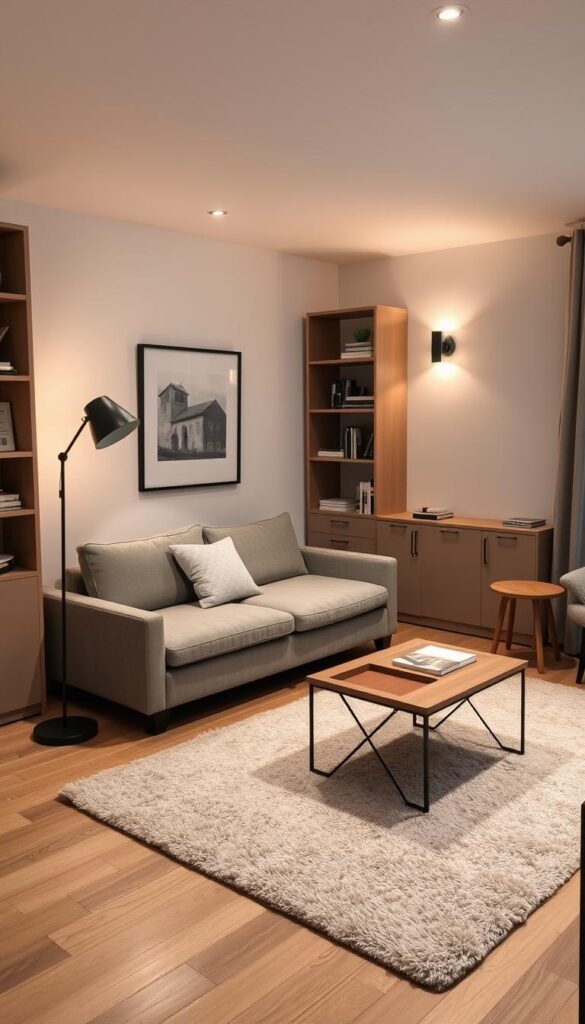
Flexible arrangements matter most. Tokyo-based firm Nendo often uses nesting side tables or ottomans that tuck under consoles when unused. For multi-use zones, try angling chairs toward a focal point like a window or artwork to define the area without physical dividers.
Look up! Vertical space is your ally. Copenhagen designer Line Depping transformed a 250-square-foot studio by mounting shelves above doorways and using an L-shaped sectional to anchor the layout. Remember: every item should serve at least two purposes or earn its keep through daily use.
Lastly, edit ruthlessly. Atlanta organizer James Carter recommends removing one piece from your initial plan. “Empty floor space between furnishings makes rooms feel larger than they are,” he notes. Test your setup by walking through the area—if you bump into anything, rethink the placement.
Optimizing Floor Space: Furniture and Storage Ideas
Smart furniture choices turn cramped quarters into versatile zones. Brands like IKEA and Sofa.com lead with designs that merge style and practicality. Their sofa beds with under-seat compartments, for instance, offer guest seating by day and hidden storage by night.

Built-in cabinets along walls maximize vertical real estate without dominating layouts. A Brooklyn studio recently used floor-to-ceiling units from IKEA’s BESTÅ line, combining display shelves with closed storage. Coffee tables with lift-up tops or nested stools add surface area while keeping essentials tucked away.
Proportional pieces prevent overwhelm. Sofa.com’s compact 72-inch Axel model includes drawers for throws, balancing form and function. For narrow areas, consider wall-mounted desks that fold flat when unused. Los Angeles designer Tina Lee transformed a 150-square-foot space using a floating console that doubles as a workspace and bar cart.
Prioritize dual-purpose items. Ottomans with hollow interiors store books, while bench seating with lift-up lids hides seasonal items. The key? Every addition should solve two problems—like a sleek media unit that also serves as a room divider.
Enhancing Natural Light and Airiness
Brightening a space starts with understanding how light interacts with surfaces. Designers at Farrow & Ball report that 78% of clients using their “All White” palette perceive rooms as 20% larger. Light-toned walls act like natural reflectors, bouncing sunlight deeper into corners.
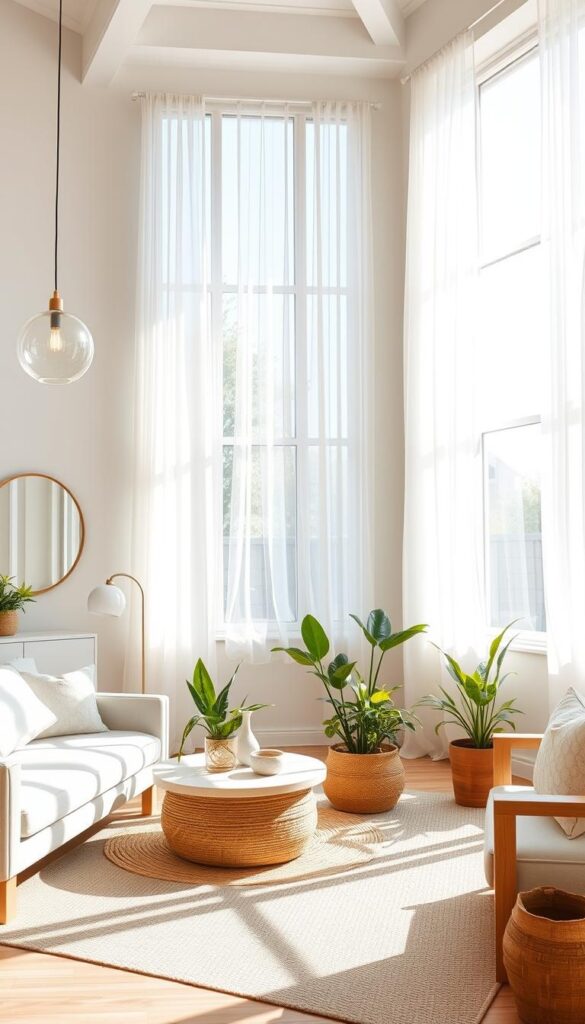
Flooring choices play a starring role too. Pale oak planks or glossy tiles amplify brightness better than dark carpets. A 2023 Houzz study showed spaces with light floors feel 30% more airy. Pair these with satin-finish wall paints to create soft luminosity without glare.
| Element | Best Choices | Light Boost Effect |
|---|---|---|
| Walls | Farrow & Ball “School House White” | Reflects 65% more light than mid-tones |
| Floor | Whitewashed oak or large-format tiles | Creates seamless visual flow |
| Surfaces | Glass coffee tables, metallic accents | Adds depth through reflection |
Ditch heavy drapes for sheer linen curtains. San Francisco designer Lena Choi transformed a dim studio by replacing blackout blinds with motorized translucent shades. This simple swap increased usable daylight by 2.5 hours daily.
For maximum impact, combine multiple strategies. Try Benjamin Moore’s “Chantilly Lace” on walls paired with light gray vinyl flooring. Add a high-gloss console table to double the sunlight’s reach. Remember: clutter-free surfaces let light dance freely through your sanctuary.
Choosing the Perfect Sofa and Seating Options
The right seating can elevate both comfort and aesthetics in compact environments. Start by measuring your available area—sofas should leave at least 24 inches of walking space on all sides. Custom solutions like Shaw’s apartment-sized Serenity Sofa, featured in a Boston case study, prove tailored pieces maximize functionality without sacrificing style.
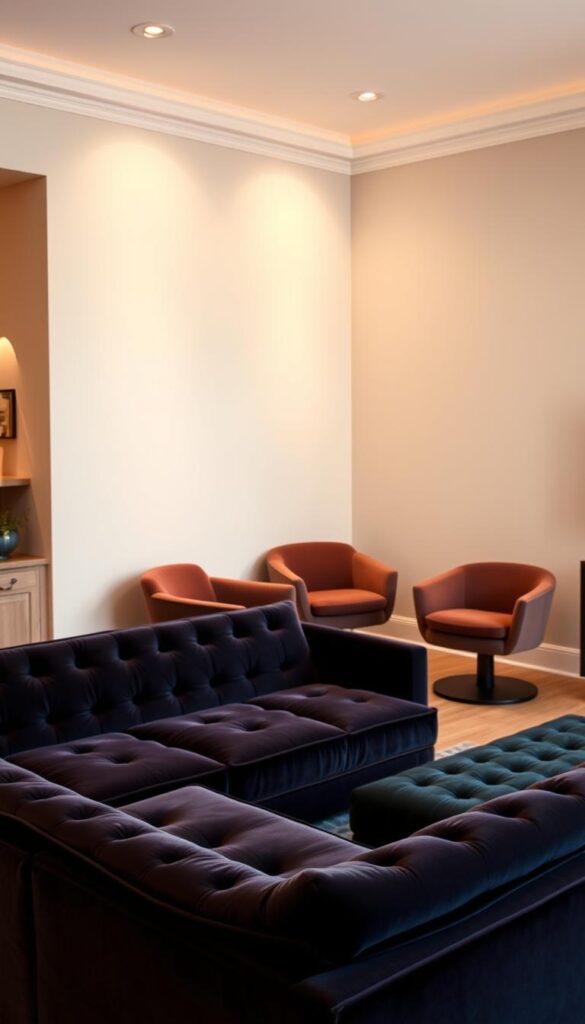
Prioritize multi-functional designs. Sleeper sofas with built-in storage or modular units that rearrange easily adapt to changing needs. A San Francisco studio gained 30% more floor space by swapping a traditional couch for IKEA’s Friheten sectional, which includes hidden compartments and converts to a guest bed.
Consider proportional armchairs and ottomans that tuck under consoles. Designer Mara Santos transformed a 200-square-foot area using two slim-scale swivel chairs instead of a bulky loveseat. Their neutral upholstery maintained a light, airy feel while providing flexible seating.
Balance practicality with personality. Reupholstered vintage chairs add character in tight spots—like a Brooklyn project where 1950s barrel chairs became the room’s focal point. Stick to clean lines and lift-up bases for hidden storage in most rooms.
Test comfort rigorously. A 2023 Houzz survey found 68% of homeowners regret prioritizing looks over seat depth. Choose pieces that support your lifestyle, whether that’s stain-resistant fabrics for families or compact chaises for solo relaxation. Your seating should reflect your style evolution while keeping the space feeling open.
Innovative Small Living Room Decor to Transform Your Space
Revamping your compact area starts with inventive accents that serve dual purposes. A Parisian studio recently gained attention for floating shelves with embedded LED lights—these display books while casting ambient glow upward, reducing visual clutter. Such solutions prove smart decor choices save time and elevate daily experiences.

Bold yet functional pieces make ideal conversation starters. Consider geometric wall panels that double as jewelry organizers, like those in a New York loft featured on Architectural Digest. For time-crunched homeowners, peel-and-stick mural wallpapers from brands like Spoonflower offer instant focal points without permanent commitments.
Three strategies balance personality with practicality:
- Modular shelving systems (like Vitsoe 606) adapt to evolving storage needs
- Magnetic boards disguised as abstract art hold keys and reminders
- Ottomans with reversible tops switch between trays and laptop stands
London designer Clara Hartman transformed a 180-sq-ft space using a foldable mural that conceals a projector screen. Her clients now enjoy movie nights and gallery-worthy walls without sacrificing square footage. This approach demonstrates how living room ideas can merge entertainment with elegance.
Don’t shy from mixing textures and functions. A Seattle apartment made waves by pairing a leather-wrapped radiator cover with floating acrylic side tables. These time-saving updates prove you can maintain openness while expressing personal flair. Experiment with unexpected materials—concrete planters that hold charging stations or velvet curtains with hidden blackout liners.
Creative Storage and Clutter Solutions
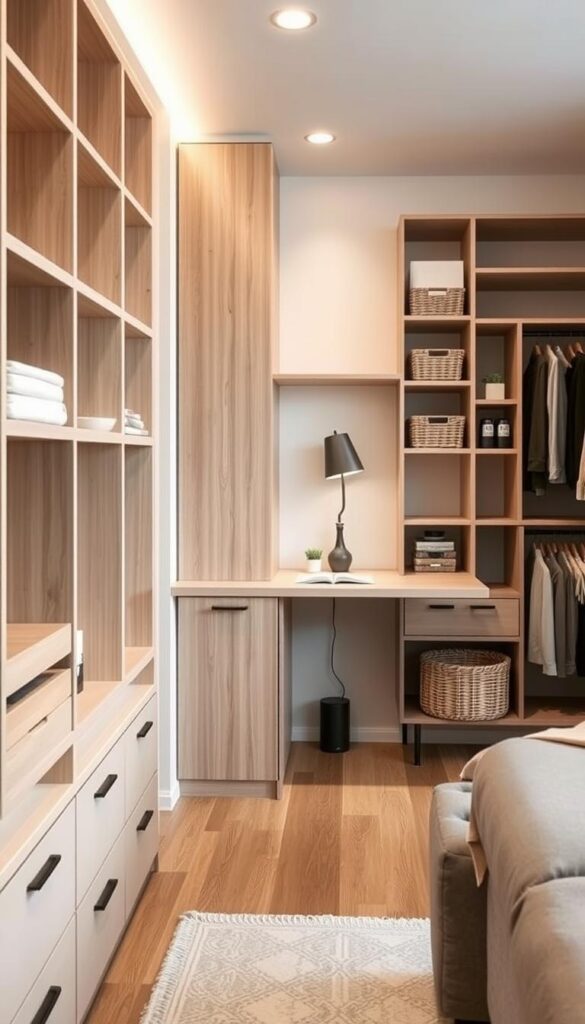
Unlocking hidden potential starts with storage that works smarter, not harder. Vertical solutions like wall-mounted cubbies or floating shelves from brands like IKEA and West Elm keep floors clear while showcasing plants or art. A Miami designer recently used ceiling-high ladder shelves to store books and display ceramics, proving practicality can be pretty.
Dual-purpose furniture steals the show. Think ottomans with lift-up lids for blankets or beds with built-in drawers. The best small living furniture balances form and function—like CB2’s Axis console, which hides charging stations behind its sleek facade. These pieces make room feel more open by eliminating visual chaos.
Arrange items strategically to make space feel less cramped. Use trays to corral remotes on coffee tables, or install magnetic strips inside cabinet doors for spice jars. Boston organizer Jess Wu suggests labeling bins with photos instead of words. “It streamlines decisions and adds personality,” she notes.
Don’t ignore vertical real estate. High cabinets above doorways or narrow floor-to-ceiling units maximize every inch. A Seattle studio gained 40% more storage by using a rolling library ladder to access top shelves. This approach keeps essentials handy without crowding walkways—key for maintaining that airy vibe.
Using Color and Paint to Expand Perception
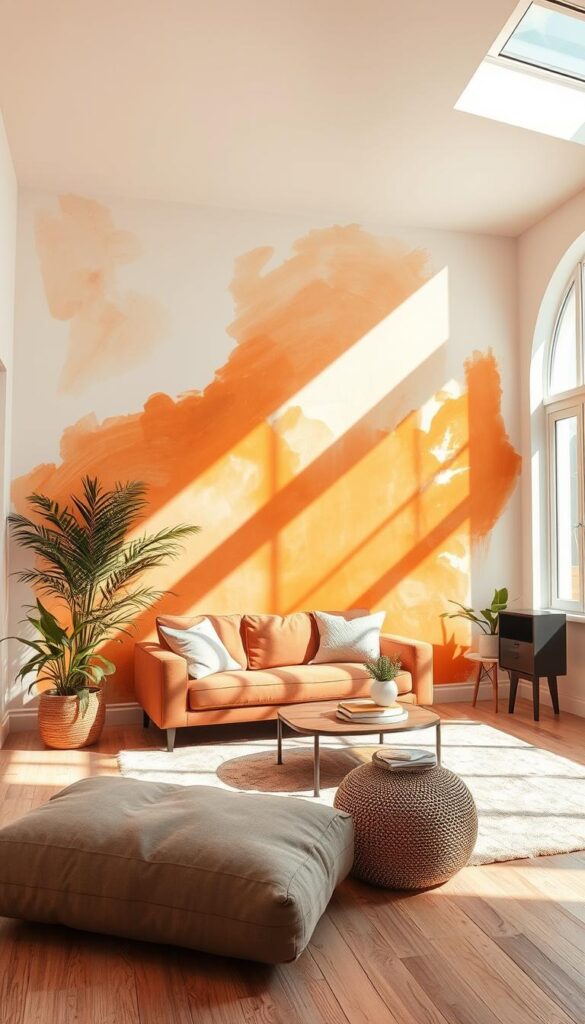
Color wields transformative power in shaping how we experience environments. Light-reflecting hues like Benjamin Moore’s “Chantilly Lace” can trick the eye into perceiving added depth, making walls seem farther apart. A 2023 study found spaces painted in pale blues or soft grays feel 25% more expansive due to their light-bouncing properties.
Designers use clever strategies to stretch compact areas visually:
- Monochromatic schemes blend walls and trim, erasing visual boundaries
- Darker accent walls create depth illusions (try Farrow & Ball’s “Hague Blue”)
- Semi-gloss finishes on moldings reflect light upward, lifting perceived ceiling height
New York designer Clara Torres transformed a 200-square-foot studio using vertical stripes in varying white tones. This technique drew the eye upward, making 8-foot ceilings appear loft-like. For cohesion, she extended the palette to window frames and built-ins, creating fluid movement through the space.
Bold trims offer surprising benefits. Painting baseboards 2-3 shades darker than walls grounds the area while maintaining airiness. In a Boston project, emerald-green door frames became focal points that distracted from the narrow footprint, proving daring choices can enhance room feel without overwhelming.
When selecting shades, consider their reflective values. Warm neutrals like “Calm” by Benjamin Moore work with most lighting conditions, while cool tones amplify north-facing light. Test samples at different times—the right hue makes all the difference in crafting inviting room ideas that breathe.
Displaying Art and Decorative Pieces
Art transforms cramped areas into expressive zones without eating up square footage. In tight quarters, a single oversized canvas can make room feel grander by drawing the eye upward. A Brooklyn studio featured on Dwell used vertical frames along a narrow hallway, creating rhythm while saving horizontal space.
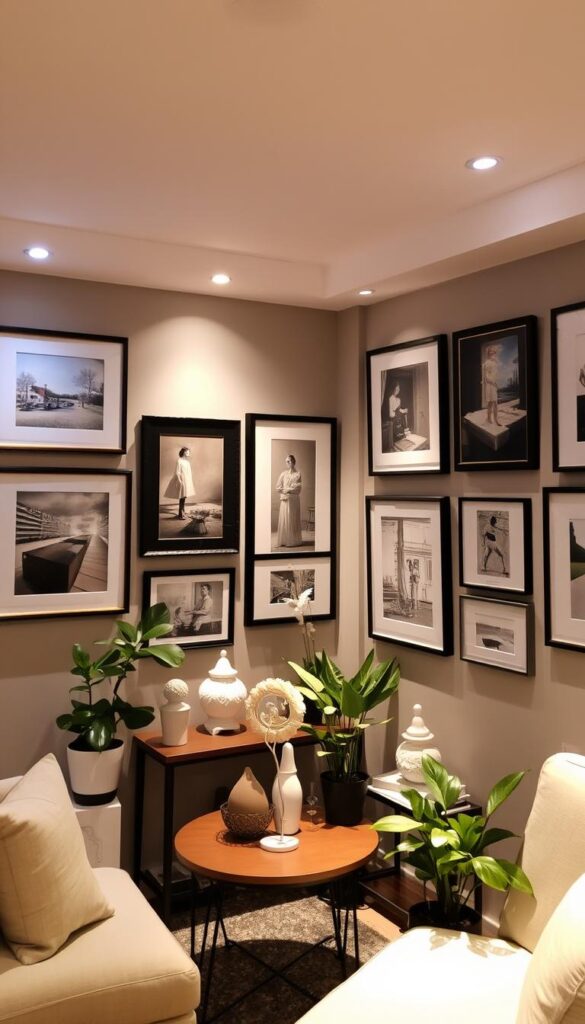
Balance is key. Mix slim floating shelves with textured woven wall hangings to add depth. Parisian designer Élodie Renaud clusters small ceramic plates above a sofa—this trick organizes visual weight while keeping surfaces clear. Stick to odd numbers (3 or 5 items) for dynamic asymmetry.
| Arrangement Style | Key Benefit | Example |
|---|---|---|
| Grid Layout | Creates order in busy areas | Identical black frames with botanical prints |
| Vertical Stack | Makes ceilings appear taller | Four vertical photos above a console |
| Mixed Media Cluster | Adds tactile interest | Wood carvings + framed textiles + metal sconces |
Scale matters. Choose one statement piece per wall—like a round mirror with a chunky frame—to anchor the space feel. Atlanta artist Jamal Pierce uses 24″x36″ abstract paintings in small rooms, proving bold art prevents a cluttered look.
Layer textures thoughtfully. Combine matte canvas prints with glossy acrylic trays on shelves. A Seattle apartment featured on Apartment Therapy paired rattan wall baskets with metallic sculptures, achieving balance through contrast. Remember: every piece should spark joy while serving the room’s flow.
Maximizing Multi-Functional Furniture
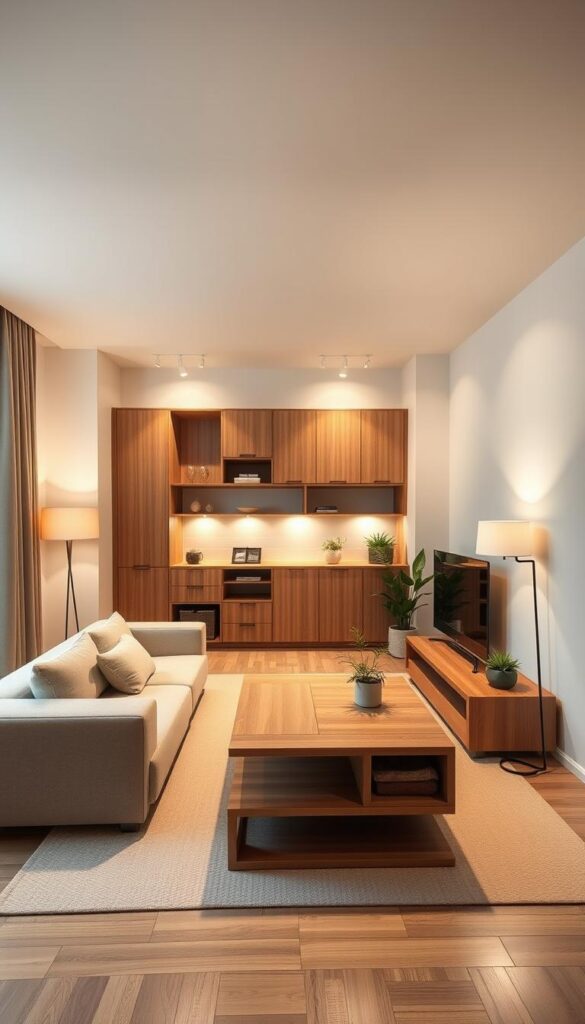
When square footage is limited, every piece must earn its keep through clever versatility. Designers love pieces that pull double duty—like a sleek console that unfolds into a dining table or ottomans with secret compartments. These solutions prove practicality doesn’t require sacrificing aesthetics.
Modern brands blend form and function seamlessly. Floyd’s modular shelving adapts to display books or hide office supplies, while Burrow’s Nomad sofa includes built-in USB ports and adjustable headrests. A Boston project featured CB2’s Axis coffee table—its lift-top design serves as a laptop desk during remote work hours.
| Furniture Type | Style Integration | Key Functions |
|---|---|---|
| Sofa Bed | Mid-century legs + linen upholstery | Guest sleeping + daytime seating |
| Nesting Tables | Marble tops + brass accents | Surface space + compact storage |
| Storage Ottoman | Velvet exterior + leather handles | Footrest + blanket storage |
New York designer Clara Wu transformed a 400-sq-ft studio using West Elm’s Peggy sofa. Its hidden drawers hold board games, while the chaise extension creates a reading nook. “Invest in pieces that solve three problems,” she advises. “Comfort, storage, and visual impact.”
Prioritize materials that withstand daily transformations—think scratch-resistant finishes or performance fabrics. The best small-friendly designs maintain cohesion through neutral tones and clean lines, letting your space style shine without clutter.
Tips for Creating a Cohesive Design Theme
A unified design scheme acts like visual glue, binding elements into a harmonious whole. Take inspiration from a Brooklyn studio featured in Architectural Digest: its monochromatic gray palette flows from walls to area rugs, creating seamless continuity. This strategy helps compact zones feel larger by eliminating visual interruptions.

Consistent textures and materials reinforce cohesion. A Seattle project achieved this by repeating brass accents in lighting, cabinet pulls, and table legs. These ideas require small adjustments but yield significant impact—like matching throw pillows to artwork frames or choosing side tables with similar wood tones.
| Design Element | Cohesion Strategy | Visual Impact |
|---|---|---|
| Color Palette | Use 3 main shades across surfaces | Unifies sightlines |
| Texture Mixing | Repeat 2 materials in furniture/decor | Adds depth without chaos |
| Furniture Style | Match leg shapes or upholstery types | Creates rhythm |
Successful projects prove cohesion amplifies organization. A Tokyo apartment used identical storage baskets under consoles and beside seating, making space appear curated. This approach helps your area feel larger by guiding the eye smoothly through the layout.
Balance personal flair with coordination. Display collections in matching frames or group varied plants in similar pots. As seen in a Miami designer’s work, navy-blue book spines became an intentional accent when repeated across shelves. Thoughtful cohesion can make space appear organized while reflecting your unique taste.
Budget-Friendly Updates and DIY Projects
Revitalizing your space doesn’t demand a big budget—just clever creativity. Start with a fresh coat of paint: light-reflecting shades like Benjamin Moore’s “Simply White” instantly brighten walls and make areas feel more open. For under $50, this update delivers maximum impact with minimal effort.

Transform plain surfaces with removable wallpaper. Brands like Tempaper offer peel-and-stick patterns that add vibrant color without damaging walls. A Chicago renter recently created an accent wall with tropical leaf prints, spending just $120 for a bold focal point.
Upgrade lighting affordably with these ideas:
- Swap outdated fixtures with thrifted brass pendants ($25-$80)
- DIY rattan lampshades using craft store materials
- Add plug-in wall sconces to free up floor space
Reupholstering chair seats with remnant fabric injects new life into tired furniture. Pair this with DIY floating shelves made from stained scrap wood for personalized wall decor. These projects cost less than $75 but create designer-level charm.
| Project | Cost | Time | Style Impact |
|---|---|---|---|
| Paint Accent Wall | $35 | 3 hours | High |
| Thrifted Art Display | $20 | 1 hour | Medium |
| DIY Mirror Frame | $15 | 2 hours | High |
For instant updates, layer textured throw pillows in coordinating colors. A Portland designer refreshed a client’s space using $40 worth of geometric-print covers from Etsy. Remember: test paint samples at different times to see how light changes their appearance before committing.
Lighting Strategies to Enhance Your Space
Lighting shapes how we experience our homes, blending mood with practicality. A well-lit area feels inviting day and night. Start by layering three types: ambient, task, and accent. This approach ensures flexibility for movie nights, reading sessions, or lively gatherings.
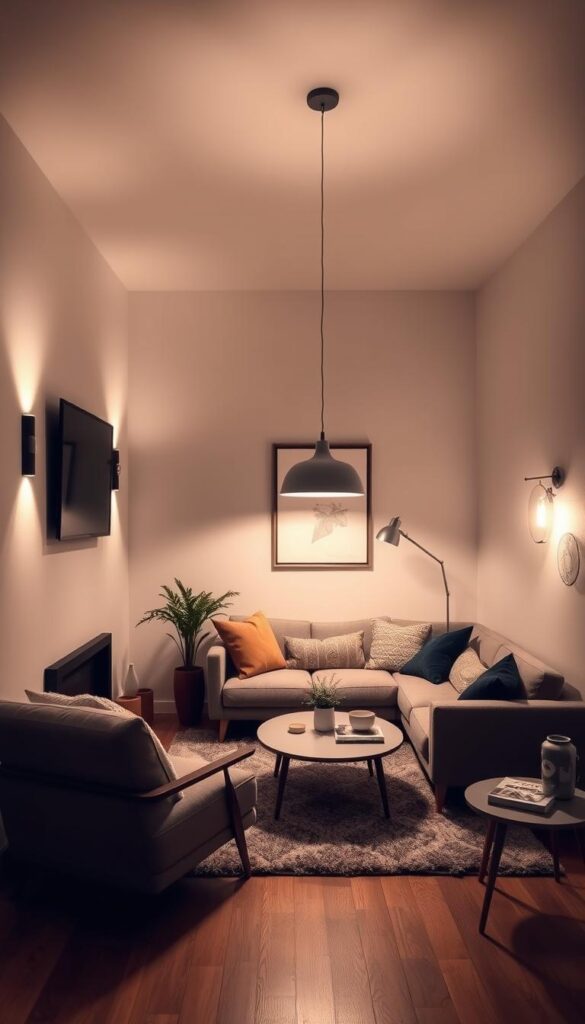
Wall-mounted options save floor space while adding style. Sputnik-style sconces flanking a gallery wall create symmetry. Pendant lights over seating zones define areas without bulky floor lamps. Brands like West Elm offer plug-in designs for renters—no hardwiring needed.
| Lighting Type | Best Placement | Key Benefit |
|---|---|---|
| Adjustable Sconces | Above side tables or artwork | Directs light where needed |
| Dimmable Pendants | Over dining nooks or consoles | Sets adjustable ambiance |
| LED Strip Lights | Under shelves or cabinets | Adds subtle glow |
For reading corners, pair swing-arm lamps with plush chairs. A 2023 Apartment Therapy feature highlighted angled lights reducing eye strain. Choose warm bulbs (2700K-3000K) near seating to mimic natural sunset hues.
Highlight architectural details with strategic spots. Uplighting a textured wallpaper accent wall adds depth. Philips Hue smart bulbs let you switch tones via app—bright white for mornings, amber for evenings. This tech-forward solution keeps spaces feeling current.
Experiment with unexpected sources. Battery-powered puck lights inside glass cabinets showcase collectibles. A San Francisco studio used rope lights along ceiling beams to visually lift low ceilings. Remember: layered lighting solves multiple needs while making areas feel airier.
Incorporating Unique Accents and Textures
Textures and accents shape a space’s character more than square footage ever could. A 2023 DecorLabs study found rooms blending three material types feel 40% more dynamic. Think velvet cushions against matte walls or hammered metal lamps beside rustic wood—these contrasts spark visual intrigue while reflecting personal style.

Accent tables play starring roles in defining color palettes. Try a lacquered side table in burnt orange beside neutral seating. This pop of color anchors the scheme while providing utility. Vintage finds add soul—like a 1970s brass tray holding modern ceramics.
Balance thrives in unexpected pairings. Designer Nina Campbell transformed a studio using:
- Concrete planters with silk flowers
- Woven wall hangings near glossy shelves
- A reclaimed door turned coffee table
| Material Pairing | Effect | Example |
|---|---|---|
| Rough + Smooth | Adds tactile depth | Bouclé chair under steel artwork |
| Matte + Glossy | Creates light play | Eggshell walls with patent leather ottoman |
| Organic + Manufactured | Builds contrast | Driftwood bowl on geometric tray |
Stick to your core palette when experimenting. If walls are sage green, introduce emerald glassware and mint throw blankets. This maintains harmony while letting bold textures shine. Remember: cohesion comes from repeating colors, not matching materials perfectly.
Adapting Design Elements to Fit Your Lifestyle
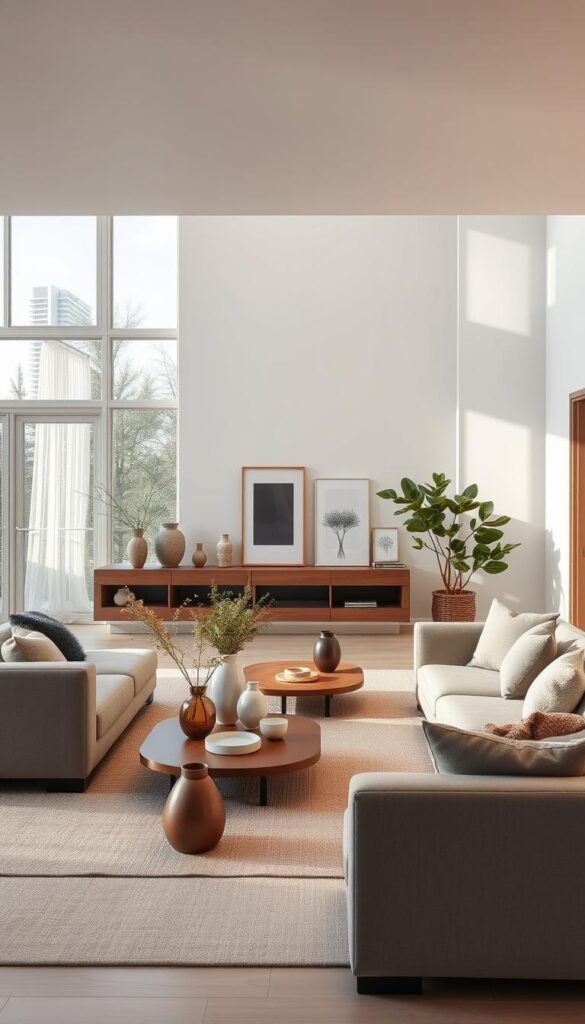
Your home should reflect how you live, not just follow trends. Start by evaluating daily routines—do you work remotely, host friends weekly, or need quiet reading corners? A Parisian studio redesigned their area using a modular sofa that converts into a guest bed and charging station. This approach blends comfort with practicality seamlessly.
Positioning furniture near windows boosts both function and mood. A Chicago loft used sheer curtains and a floating desk beside floor-to-ceiling panes. Natural light enhances productivity during work hours, while evening lamp glow creates cozy ambiance. Adjustable shelving units nearby hold supplies without blocking views.
| Design Element | Lifestyle Fit | Example |
|---|---|---|
| Convertible Desks | Remote work + dining | Wall-mounted fold-down table |
| Movable Dividers | Parenting + entertaining | Acrylic panels on casters |
| Multi-Level Storage | Hobbies + minimalism | Rotating craft supply tower |
Urban spaces shine when style meets adaptability. Brooklyn’s NEST Architects transformed a 400-sq-ft area using nesting coffee tables that stack as stools. The design accommodates yoga sessions and dinner parties equally well. Neutral tones keep the look cohesive despite changing uses.
Prioritize pieces that grow with you. A San Francisco renter chose modular shelving that reconfigures for records, plants, or home office gear. This flexibility ensures your area evolves alongside new hobbies or family needs. Remember: great design solves today’s problems while anticipating tomorrow’s possibilities.
Conclusion
Transforming compact areas into stylish retreats proves that smart design trumps square footage every time. Throughout this guide, we’ve explored how multi-functional furniture, strategic shelving solutions, and layered lighting create inviting environments. These approaches help maintain organization while maximizing visual flow.
Thoughtful solutions like vertical storage systems or convertible seating address spatial challenges without sacrificing personality. Shelving that doubles as room dividers or display spaces keeps essentials accessible yet discreet. Balancing practical choices with cohesive color schemes ensures your zone feels intentional rather than cramped.
Start with one change—a floating shelf here, a modular ottoman there—and build momentum. Experiment with textures or rearrange existing pieces to discover fresh layouts. Even minor updates, like swapping dark curtains for light-filtering shades, can dramatically shift a space’s energy.
Ready to see the difference? Apply these strategies to craft a home that works as beautifully as it looks. Share your before-and-after stories using #SmartSpaceSolutions—we’d love to celebrate your creative wins!
FAQ
How do I choose furniture that maximizes floor space?
Opt for slim-profile pieces like IKEA’s Stockholm sofa or West Elm’s modular sectionals. Use nesting tables, ottomans with hidden storage, or wall-mounted shelves to keep surfaces clear and functional.
What paint colors make a tight area feel larger?
Light neutrals like Benjamin Moore’s Simply White or Sherwin-Williams’s Agreeable Gray reflect light, creating an airy vibe. Monochromatic schemes or soft pastels also stretch visual boundaries without overwhelming.
Can I add bold decor without cluttering the area?
Yes! Focus on one statement piece, like a vibrant CB2 rug or a framed abstract print. Pair it with minimalist accents, such as metallic lamps or geometric throw pillows, to balance impact and simplicity.
How do I improve natural light in a dim space?
Hang sheer curtains from brands like Pottery Barn, place mirrors opposite windows, and opt for glossy finishes. Trim outdoor foliage and use light-filtering window films to brighten the ambiance.
What storage solutions work for limited square footage?
Try Target’s Threshold floating shelves, under-sofa bins, or multi-tiered console tables. Built-in nooks or storage ottomans from brands like Article keep essentials handy without sacrificing style.
Are sectionals a good fit for compact layouts?
Yes—choose apartment-sized sectionals, such as the Floyd Sleeper Sofa, or a loveseat with a chaise. Ensure proportions align with your floor plan, leaving 18–24 inches for walkways.
How can I create a cohesive design theme?
Stick to a unified color palette and repeat materials like wood or metal. Brands like Crate & Barrel offer curated collections to mix textures and patterns while maintaining harmony.
What budget-friendly updates refresh the look quickly?
Swap throw pillow covers, add peel-and-stick wallpaper from Tempaper, or DIY floating shelves. Thrift stores and Facebook Marketplace are great for affordable vintage finds.
Can lighting make a cramped area feel bigger?
Absolutely! Layer lighting with plug-in sconces (like those from Urban Outfitters), a slim floor lamp, and dimmable overhead fixtures. Avoid bulky designs to maintain an open feel.
How do I incorporate art without overcrowding walls?
Create a small gallery wall with matching frames or lean a large-scale painting against the wall. Brands like Minted offer scaled-down prints perfect for narrow spaces.
